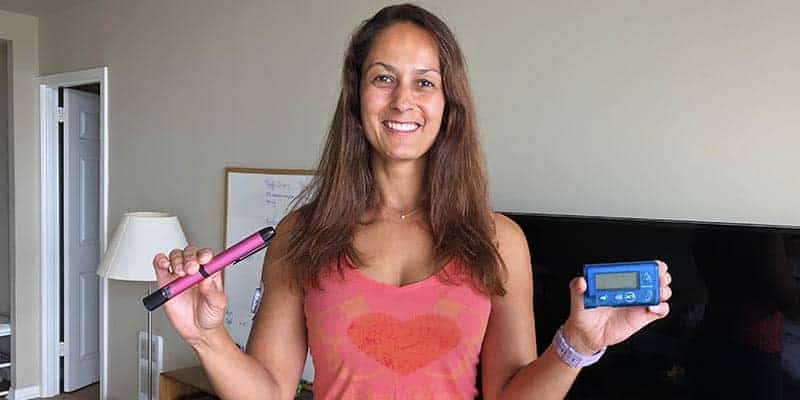I’ve lived with type 1 diabetes since 1997, and I have been managing my diabetes with insulin injections (multiple daily injections – MDI) since day one. I briefly tried an insulin pump, and it was not for me, so I’m back to being happy and thriving doing MDI.
In this post, I’ll walk you through my journey and why I choose to use insulin pens over an insulin pump.
My goal with this article is not to sway you either way, but to tell you my experience and to give you the rundown of the pros and the cons of insulin pumps and insulin pens respectively.
With the right knowledge, we can make informed choices, and it will be up to you to choose what seems right for you. There’s no one-size-fits-all with anything when it comes to diabetes.

Table of Contents
My device journey
When I was diagnosed with type 1 diabetes in 1997, I was handed a blood glucose meter and a prescription for prefilled insulin pens. Prefilled means that the insulin was already in the pens, all I had to do was screw on the needle and draw up the number of units I wanted to dose. When empty, I just tossed the pens in the trash.
As with anyone on MDI, I was prescribed short-acting insulin to cover food (bolus) and long-acting insulin to act as background insulin (basal).
I don’t remember exactly what type of insulin I was prescribed but it required me to eat certain times — it was probably NPH insulin. This basal insulin had a little ball in the mixture (like some bottles of nail polish do), and I had to gently move the ball through the liquid to mix it before use. Not exactly optimal, but it worked.
As newer insulins came to the market, I switched to using Levemir as my basal insulin and Humalog as my rapid-acting insulin, covering food and corrections for highs.
The only thing that has changed for me since is switching from a prefilled Humalog pen to a durable pen, and then from a normal durable pen to a durable Smartpen. A durable pen simply means that the pen is reused and only the insulin cartridge is tossed when empty.
The upside of a durable pen is that it can give ½ units of insulin (the prefilled used to only be able to do 1-unit increments). The upside of a Smartpen (I use an InPen) is that it helps keep track of my active insulin on board (IOB), supports me in calculating my doses, reminds me when I need to take my basal insulin, and automatically records (through Bluetooth to my phone) all the injections I take.
I’ve also added a continuous glucose monitor (CGM) to my diabetes toolbox, and that has been a real game changer.
When I tried rocking a pump and why it didn’t work for me
In December 2017, 20 years into my life with diabetes, I decided to try an insulin pump. I wanted the best care, so I decided to try Looping. Looping is a DIY (Do It Yourself) version of the artificial pancreas technology.
A normal insulin pump will automatically (based on what it’s programmed to do) deliver small amounts of rapid-acting insulin, such as Novolog, Humalog, or Apidra, 24/7.
You still have to prompt the pump to give you a bolus for food or correction, but the background insulin is programmed and automatic.
With Looping (the DIY system) and the newest Medtronic 670G system, the pump takes it one step further by adjusting your basal insulin doses based on your CGM readings.
If the system thinks your blood sugars will go too low, it will suspend administering insulin until it determines that your blood sugar is at a safe and stable level. If it thinks your blood sugar is rising, it will give you more insulin.
This is brilliant, and I’m such a huge fan of the technology, but there is a problem. And that problem, and ultimately why an insulin pump didn’t work for me, is that the pumps are pumping rapid-acting insulin 24/7.
The drawbacks of rapid-acting insulin
Rapid-acting insulins such as Novolog, Humalog or Apidra take 15 to 20 minutes to reach the bloodstream once injected. It doesn’t peak until 1 to 3 hours after it is injected, and it will stay in the body for 3 to 5 hours total.
The new kid on the block, Fiasp, hits the bloodstream and peaks a few minutes faster, but similar to the other rapid-acting insulins, it stays active in the body for 4 to 5 hours.
The risk of DKA
So, if you’re on a pump, you’ll need rapid-acting insulin to be circulating at all times to prevent Diabetic ketoacidosis (DKA) from happening (assuming you have no insulin production whatsoever). Should the pump malfunction and stop delivering insulin, you’re at a heightened risk of going into DKA and ending up in the hospital.
If you take your insulin via MDI, which means you always have background insulin on board, the risk of DKA is much lower (this, of course, assumes you don’t forget to take your daily background insulin dose.)
Low blood sugars & exercise
Since rapid-acting insulin lasts 3 to 5 hours, those using an insulin pump need to be very proactive in planning exercise or any movement at all. When exercising, going for a walk, or doing everyday tasks like vacuuming, you’re at risk of experiencing low blood sugar if you have too much rapid-acting insulin onboard. Since an insulin pump delivers rapid-acting insulin all the time, you most likely will have too much insulin in your system for any type of spontaneous movement the majority of the time.
Whether or not we use an insulin pump or MDI, we all need to adjust our rapid-acting insulin if we want to exercise or move around without going low. However, on MDI I only have to worry about any bolus injections I’ve taken in the last 4 hours since my basal insulin hardly gets impacted by activity.
When using an insulin pump, I also had to worry about the insulin I’d received as basal for the last 4 hours. Of course, that can be done. But for me, all that basal adjusting was just much more of a hassle compared to using MDI to manage my insulin.
Pumps have benefits but not enough for me
As mentioned, I was Looping so the pump would adjust my insulin when it estimated that I was about to have a low or high blood sugar. And it did, just not effectively enough.
Since rapid-acting insulin lasts for 4 to 5 hours in the body, there was no way the Loop system could keep up with my activity level. Yes, it got smarter, but my days are rarely the same and I’m a very active individual. I was dropping low way too frequently unless I disconnected and micromanaged the entire program.
For many, the system is life-changing. If we had access to insulin that worked faster and had a shorter duration, I’d probably be using an insulin pump.
The upside of basal (long-acting) insulin
Basal insulin doesn’t get impacted by activity in the same way as rapid-acting insulin. That means that I only have to think about adjusting my mealtime and correction boluses if I intend to exercise or just be active. That means that if I decide to exercise right out of bed, there is no adjusting insulin. I just go. Same deal with afternoon exercise, as long as it’s more than 4 hours after the last bolus.
Some guidelines say to reduce long-acting basal insulin on days when exercise is planned, and I sometimes do that. But all I adjust is my nighttime basal. My endo suggested splitting my basal into a morning and an evening dose, and it has worked wonders for me.
I keep my daytime dose the same (except for days where I’ll be sitting all day, like during a long flight, then I’ll increase it) and adjust my nighttime basal depending on my activity level. That means that I don’t have to plan ahead when it comes to my dose. I adjust it after the day is over.
Pros and cons
When it comes to choosing whether to manage your insulin with injections or an insulin pump, the choice is very personal — and the choice is yours! Both methods have their pros and cons.
Pros of using an insulin pump
- Ability to set a variety of basal rates to match your personal needs, with the option to set small dosing increments
- Some integrated systems can adjust insulin based on CGM readings
- Pumps keep track of IOB, help calculate doses, and have detailed reporting available
Cons of using an insulin pump
- Being disconnected for more than 4 hours or pump failures can quickly lead to DKA
- The modern insulins last too long in the body for the modern pump systems to really make sense
- Having to be attached to a device 24/7
Pros of multiple daily injections
- Long-acting basal insulin hardly needs adjustment for activity
- Not having another device attached to you
- Less risk of DKA due to basal insulin and no device failure
Cons of multiple daily injections
- ½ unit is the smallest unit increment you can dose
- Basal can only be adjusted 1 to 2 times daily (depending on whether you split your dose) and the impact of that adjustment isn’t immediate
- Regular pens (not Smartpens) do not have a bolus calculator or track IOB
What’s right for you: injections or a pump?
So maybe you love your insulin pump or your insulin pens, or maybe you’re ready for a switch. Maybe you’re wondering if the grass is greener on the other side and switching to a different insulin delivery method would improve your diabetes management and make life easier.
In my opinion, you can achieve healthy blood sugar levels with both methods. What determines your success is how that method of insulin delivery fits with your lifestyle, your personality, and your willingness to deal with the cons of either method.
For some, the risk of DKA with a pump doesn’t outweigh the stress of having to take at least 4 to 6 insulin injections every day.
When I asked the Diabetes Strong community on Instagram if they used an insulin pump or MDI, the responses came back 50/50, which seems to indicate that my theory of there not being a “one-size-fits-all” is true.
I hope this post helped give you a more nuanced picture of the “Pump versus MDI” discussion. And if nothing else, you got to know me a little better.




Stephen
T1 for 54 years. Have never used a pump. A1c stays at 5.7-6.2. In Range is around 90%. I pay close attention to my Dexcom. Why would I switch to a pump?